|
First
Station
Jesus is condemned to death.
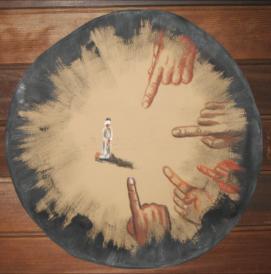
As soon as it was morning, the chief priests, with the elders
and scribes, and the whole council, held a consultation; and
they bound Jesus and led him away and delivered him to
Pilate. And they all condemned him and said, “He deserves
to die.” When Pilate heard these words, he brought Jesus out
and sat down on the judgment seat at a place called the
Pavement, but in the Hebrew, Gabbatha. Then he handed
Jesus over to them to be crucified.
1. Jesus is
condemned to death—Kirsten Anderson,
conté crayon on paper
It's so easy to identify with the victim—the sadness of an innocent
person wrongly accused and wrongly condemned. It's so easy to
feel tiny and powerless. It's much harder to look at our shadow
side, the possibility that we (as individuals and a society) at times
might have more in common with the oppressors rather than the
oppressed, the accusers more than the accused. So, that is what I
wanted to do—explore the shadow.
Second
Station
Jesus
takes up his Cross
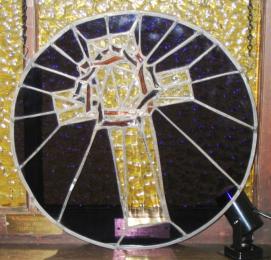 Jesus went out, bearing his own cross, to the place
called the
place of a skull, which is called in Hebrew, Golgotha.
Although he was a Son, he learned obedience through what
he suffered. Like a lamb he was led to the slaughter; and like
a sheep that before its shearers is mute, so he opened not his
mouth. Worthy is the Lamb who was slain, to receive power
and riches and wisdom and strength and honor and glory
and blessing. Jesus went out, bearing his own cross, to the place
called the
place of a skull, which is called in Hebrew, Golgotha.
Although he was a Son, he learned obedience through what
he suffered. Like a lamb he was led to the slaughter; and like
a sheep that before its shearers is mute, so he opened not his
mouth. Worthy is the Lamb who was slain, to receive power
and riches and wisdom and strength and honor and glory
and blessing.
2. Jesus takes up
his cross—Sharon & Jerry Fishel, stained glass
I am from the Jesus Christ Superstar generation; the one that said
"Jesus Christ, Superstar, do you think you're who they say you
are?" When I saw Mel Gibson's the Passion of the Christ it said to
me that yes, Jesus did think he was the Christ and he willingly took up
the cross, which was not a fun, easy, or pretty thing to do. In
fact the graphic portrayal of what taking up that cross meant was a
profound experience for me. So…when I went to make a symbol of
that act I wanted to show that the cross was not just a pretty thing,
but a prickly one.
We had a good experience coming up with the design. I went to the
glass shop looking for patterns and met a young woman who grew up
attending the National Cathedral. It was a rainy day and there
was hardly anyone in the shop. She really got into finding me
patterns and designs. I took some home and told Jerry what I was
trying to accomplish; Jerry put the designs together. I loved the
pattern he made. He said he felt inspired when he drew it.
We then together went and chose glass to bring it to life.
Third
Station
Jesus
falls the first time
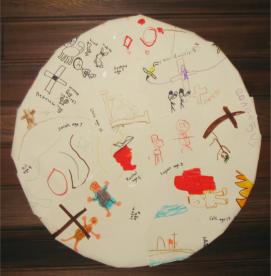
Christ Jesus, though he was in the form of God, did not
count equality with God a thing to be grasped; but emptied
himself, taking the form of a servant, and was born in
human likeness. And being found in human form he humbled himself and
became obedient unto death, even
death on a
cross. Therefore God has highly exalted him, and bestowed on him
the name which is above every name. Come, let us
bow down, and bend the knee, and kneel before the Lord our
Maker, for he is the Lord our God.
3. Jesus falls
for the first time—Anne Ritchey and Sunday School, collage
Sunday School Project
The diversity of the drawings done by the Sunday School children
illustrates so well their compassion for Jesus. This project
provided them with a wonderful opportunity to "live" the Passion of
Christ. The children are so proud to have their work displayed in
church.
The artists are: Rebecca
Waller, Sydney Hudson, David Waller, Cecelia Kerns, Logan Hudson,
Rachel Townsend, Jason Ritchey, Celestine Glover, Jeremy Ritchey,
Duquan (D.J.) Ruff, Sara Townsend, and Chris Mello.
Fourth
Station
Jesus
meets his afflicted mother
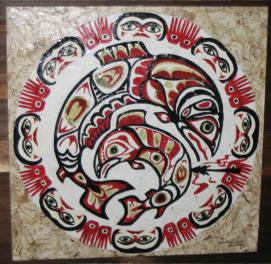 To what can I liken you, to what can I compare you, O daughter of
Jerusalem? What likeness can I use to comfort you, O virgin
daughter of Zion? For vast as the sea is your ruin. Blessed
are those who mourn, for they shall be comforted. The
Lord will be your everlasting light, and your days of mourning
shall be ended. To what can I liken you, to what can I compare you, O daughter of
Jerusalem? What likeness can I use to comfort you, O virgin
daughter of Zion? For vast as the sea is your ruin. Blessed
are those who mourn, for they shall be comforted. The
Lord will be your everlasting light, and your days of mourning
shall be ended.
4. Jesus meets
his afflicted mother—Claire Beorn Norman, cut paper on canvas
Northwest Coast art is rarely just representational; it is a symbolic
art form, drawing on the rich lore of the tribes of the Pacific coast
in which the salmon is a prominent theme. The salmon is honored
and celebrated by all coastal peoples as a powerful symbol of
self-sacrifice, regeneration, and perseverance. According to one
Coast Salish artist, “It is said that the Salmon People took pity on
our lives and gave themselves to save us.”
In reality, every salmon parent sacrifices itself, fighting the current
to return to its birthplace to spawn, and then to die, so that life can
continue in its offspring. But in this allegorical piece, the
roles are reversed. The mother salmon encircles her wounded son,
guarding him with her body although it is clearly futile: he has felt
the fisher’s spear and is bound to die. Violating the privacy of
this tragic moment is a crowd of pitiless onlookers, who have yet to
realize that they, too, are wounded.
Fifth
Station
The
Cross is laid on Simon of Cyrene
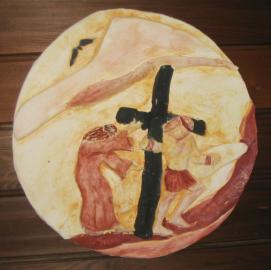
As they led Jesus away, they came upon a man of Cyrene, Simon by name, who
was coming in from the country, and laid on him the
cross to carry it behind Jesus. “If anyone would come after me,
let him deny himself and take up his cross and follow
me. Take my yoke upon you, and learn from me; for my yoke
is easy, and my burden is light.”
5. The Cross is
laid on Simon of Cyrene—Donna Brough, ceramic sculpture
When asked to participate in the "Stations of the Cross" endeavor, I
immediately chose to do Simon of Cyrene helping Jesus carry his cross.
It was not until much later, after further contemplation that I figured
out the "why" of that selection. Simon was chosen do be of
assistance and accepted somewhat reluctantly but willingly. We do
not know how he felt about this dubious honor but can only
imagine. How often do we (I) get chosen to assist with a task and
help out willingly but with some reluctance? We always seem to
hold back slightly and not embrace the sheer joy that can come from
accepting wholeheartedly the duties requested of us.
Simon was, perhaps, my lesson in doing God's work. I chose to do
the piece in my favorite medium—clay. I teach ceramics as art
therapy at the Cabrillo College Stroke Center.
Sixth
Station
A
woman wipes the face of Jesus
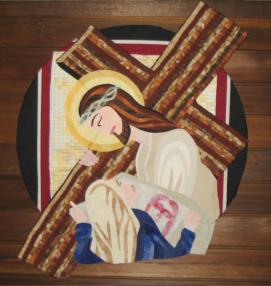 We have seen him without beauty or majesty, with no
looks to
attract our eyes. He was despised and rejected by men; a man of sorrows, and
acquainted with grief; and as one from whom men hide their
faces, he was despised, and we esteemed him not.
His appearance was so marred, beyond human semblance, and
his form beyond that of the children of men. But he was
wounded for our transgressions, he was We have seen him without beauty or majesty, with no
looks to
attract our eyes. He was despised and rejected by men; a man of sorrows, and
acquainted with grief; and as one from whom men hide their
faces, he was despised, and we esteemed him not.
His appearance was so marred, beyond human semblance, and
his form beyond that of the children of men. But he was
wounded for our transgressions, he was
bruised
for our iniquities; upon him was the chastisement that made us whole,
and with his stripes we are healed.
6. A woman wipes
the face of Jesus—Donna Ryder, fabric
Oddly enough, the first I ever heard of “Veronica’s Veil” was while
reading Anne Rice’s Memnoch
the Devil, one of the “Vampire Chronicles.” In it, the vampire
Lestat is transported throughout Christian history and at one point is
actually at the roadside as Christ passes by carrying the cross.
After Veronica wipes Christ’s face, His image is perfectly preserved on
her veil.
Having always been fascinated by the Shroud of Turin and the
possibility that Christ's image could have been preserved all these
centuries, the Veil of Veronica piqued my interest as well, and I knew
that this was the station I had to do.
There is little or no evidence that the event actually took place or
that Veronica ever existed, and there is no mention of the event in any
of the New Testament gospels. However, the Roman Catholic Church
lists Veronica among its saints, and the 'Veil of Veronica' is listed
among the many treasured relics of the Vatican, residing at St. Peter's
Basilica, where once a year it is revealed to the public. The
Veil is reputed to have miraculous curative powers.
The legend of Veronica became one of the most popular in Christian
lore, and the veil one of the beloved relics in the Church.
Nothing is known of Veronica, although the apocryphal Acts of Pilate
identify her with the woman mentioned in the Gospel of Matthew who
suffered from an issue of blood and was healed by her faith when she
touched the hem of Christ’s robe. Her name is probably
derived from the word “veraicon” which means “true image.”
Having been an avid seamstress for over 35 years, I chose fabric as my
medium, using both quilting and appliqué techniques. I am
honored and grateful to have been a part of this amazing project.
Seventh
Station
Jesus
falls a second time
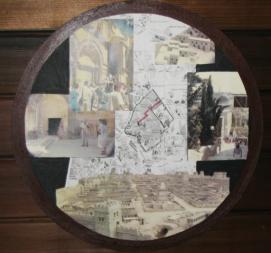
Surely he has borne our griefs and carried our sorrows. All we like sheep have
gone astray; we have turned every one to his own way; and the
Lord has laid on him the iniquity of us all. He was
oppressed, and he was afflicted, yet he opened not his mouth.
For the transgression of my people was he stricken.
7. Jesus falls a
second time—Barbara Rowland, photo montage from Jerusalem's Via
Dolorosa
Israel is…tourists. The…crucifixion. While walking there I
experienced profound feelings. It felt as if the tourists all
disappeared and I was there alone, filled with my quiet and
grief. I looked to the ground to see Christ's blood feeling of
being rolled back to that very time and place in history brought forth
such feelings of anger and helplessness; these have been burnt into my
soul and heart forever. Since my visit to Israel, I have worked
on making productive use of these feelings and never fail in my belief
of the man who died on the cross for me.
Eighth
Station
Jesus
meets the women of Jerusalem
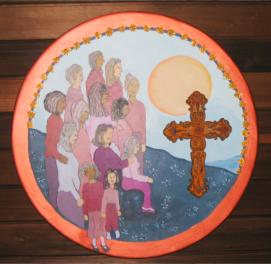
There followed after Jesus a great multitude of the people, and among them were
women who bewailed and lamented him. But Jesus
turning to them said, “Daughters of Jerusalem, do not
weep for me, but weep for yourselves and for your children.”
8. Jesus
meets the women of Jerusalem—Shealagh Devlin, mixed media
As
I searched for the meaning in this station, I discovered how
appropriate it was that I receive this station. I feel that this
station expresses the importance of women’s leadership in the Church.
In a Church that has been patriarchal for centuries, the feminine
qualities of compassion, understanding, nurture, and care of mother
earth are critical to the survival of our planet.
Ninth
Station
Jesus
falls a third time

I am the man who has seen affliction under the rod of his wrath; he has driven
and brought me into darkness without any light. He
has besieged me and enveloped me with bitterness and
tribulation; he has made me dwell in darkness like the dead of
long ago. Though I call and cry for help, he shuts out my
prayer. He has made my teeth grind on gravel, and made me cower in
ashes. “Remember, O Lord, my
affliction
and bitterness, the wormwood and the gall!”
9. Jesus falls a third
time—Charise Olson, watercolor and mixed media
I
selected this station because the title of it struck me—Jesus fell a
third time. Jesus FELL. JESUS fell. And each time he
rose and carried on. In my piece, I wanted to demonstrate the
contrast of good and evil—how they commingled in our Savior's journey
to the cross and the hope we can have in the knowledge that His good
triumphed over darkness and pain.
Tenth
Station
Jesus
is stripped of his garments
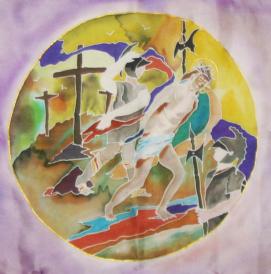
When they came to a place called Golgotha (which means the place of a
skull), they offered him wine to drink, mingled with gall; but when
he tasted it, he would not drink it. And they divided his
garments among them by casting lots. This was to fulfill the
scripture which says, “They divided my garments among them;
they cast lots for my clothing.”
10. Jesus
is stripped of his garments—Donna Seelbach, painted silk
I
have been painting on silk since 1991. I teach children art in
the summers and I work at the Cabrillo Stroke Center during the school
year. What the station brings to mind for me is how during Lent
we are laid bare before God with ourselves as we are. When
garments are ripped away from us we are vulnerable, we can no longer
hide. We are vulnerable to His working in us.
Eleventh
Station
Jesus
is nailed to the Cross
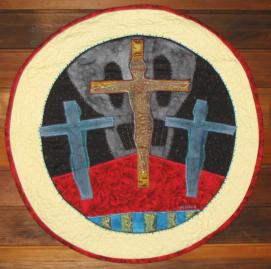 When they came to the place which is called The Skull,
there
they crucified him; and with him they crucified two criminals, one on
the right, the other on the left, and Jesus between them. And
the scripture was fulfilled which says, “He was numbered
with the transgressors.” When they came to the place which is called The Skull,
there
they crucified him; and with him they crucified two criminals, one on
the right, the other on the left, and Jesus between them. And
the scripture was fulfilled which says, “He was numbered
with the transgressors.”
11. Jesus is nailed to the cross—Nana
Montgomery, art quilt
I was drawn to do the Eleventh Station because of the strong imagery
suggested by Jesus being nailed to the cross in the place of the Skull
(Golgotha). I used the traditional colors of black, oxblood red
and ivory white along with blues and golds to complete the color
scheme. Once I had committed to the project, the layout of my
quilt came together quickly. It took a bit more time to apply the
finishing touches: paint, decorative stitching, and beads. Joining this
project for St. Andrew's Lent installation seemed like an interesting
challenge; I have been acquainted with the Stations of the Cross
through my early education in the Episcopal Church but I have not been
a regular churchgoer for many years. The project had more of an
artistic perspective for me, mixed in with a desire to portray the
familiar yet emotionally powerful scene of Jesus' hanging on the
cross. The figure is an important and recurring element in many
of the quilts that I make.
Twelfth
Station
Jesus
dies on the Cross
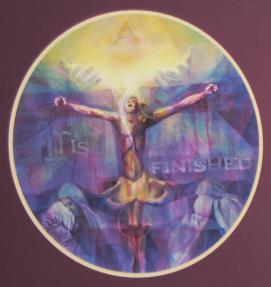
When Jesus saw his mother, and the disciple whom he loved standing near, he
said to his mother, “Woman, behold your son!” Then he
said to the disciple, “Behold your mother!” And when Jesus
had received the vinegar, he said, “It is finished!” And
then, crying with a loud voice, he said, “Father, into your
hands I commend my spirit.” And he bowed his head, and
handed over his spirit.
12. Jesus dies on
the cross—Margie Anderson, watercolor
During the last supper Christ referred to his death and told his
followers to remember him when they take the bread and the wine.
So I wanted to show the connection to Christ's death with
communion. I tried to show Christ suffering and dying and his
Spirit going into the hands of the Father and also the pain it cost God
the Father to see his son suffering. All that is really beyond
me…how the father could love me so much that in my rebellion He sent
his son to die for me. "Amazing love how could it be that Thou
shouldst die for one like me."
Thirteenth Station
The body
of Jesus is placed in the arms of his mother
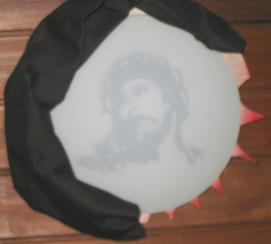
All you who pass by, behold and see if there is any sorrow like my
sorrow. My eyes are spent with weeping; my soul is in tumult; my heart
is poured out in grief because of the downfall of my
people. “Do not call me Naomi (which means Pleasant),
call me Mara (which means Bitter); for the Almighty has dealt
very bitterly with me.”
13. The body of
Jesus is placed in the arms of his mother—Kenneth Olson, mixed
media
Mary's sorrow and grief are captured as Jesus’ lifeless mortal body is
placed in her arms as he is taken from the cross. It is
contrasted by the spirit of hope, faith, and new life from Jesus having
died for our sins.
Fourteenth
Station
Jesus
is laid in the tomb
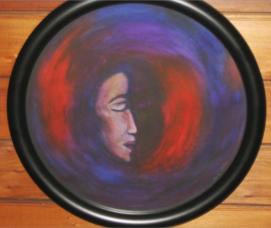 When it was evening, there came a rich man from Arimathea, named
Joseph, who also was a disciple of Jesus. He went
to Pilate and asked for the body of Jesus. Then Pilate
ordered it to be given to him. And Joseph took the body, and
wrapped it in a clean linen shroud, and laid it in his own new tomb,
which he had hewn in the rock; and he rolled a great
stone to the door of the tomb. When it was evening, there came a rich man from Arimathea, named
Joseph, who also was a disciple of Jesus. He went
to Pilate and asked for the body of Jesus. Then Pilate
ordered it to be given to him. And Joseph took the body, and
wrapped it in a clean linen shroud, and laid it in his own new tomb,
which he had hewn in the rock; and he rolled a great
stone to the door of the tomb.
14. Jesus is laid
in the tomb—April Milne, watercolor
When I was given this station I had the opportunity to talk with
Margaret Statzer, who was the original artist for this station. I was
inspired by her insight. (We) wanted to create a piece of art
that evoked individual emotion—a piece of art that allowed each viewer
to see and experience the station in their own way.
|

